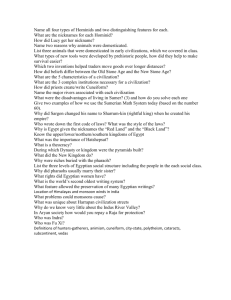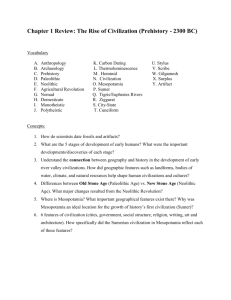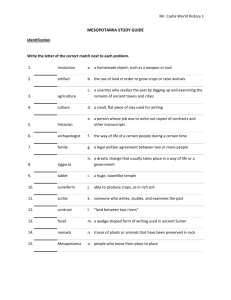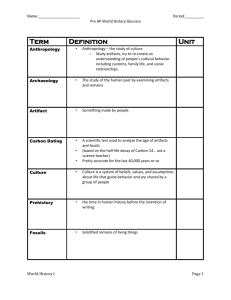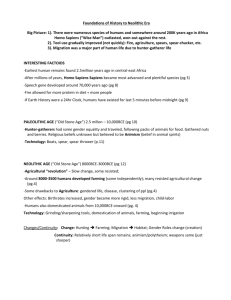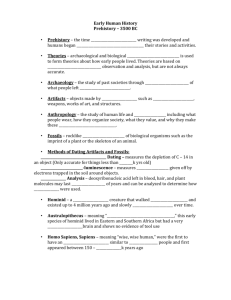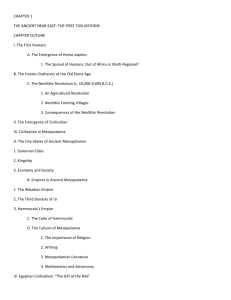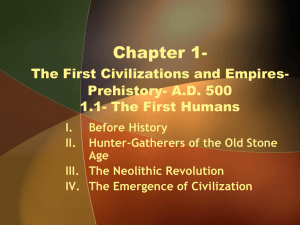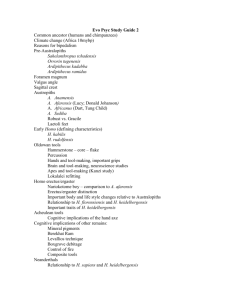Chapter 1: Early Humans and the First Civilization The First Humans
advertisement
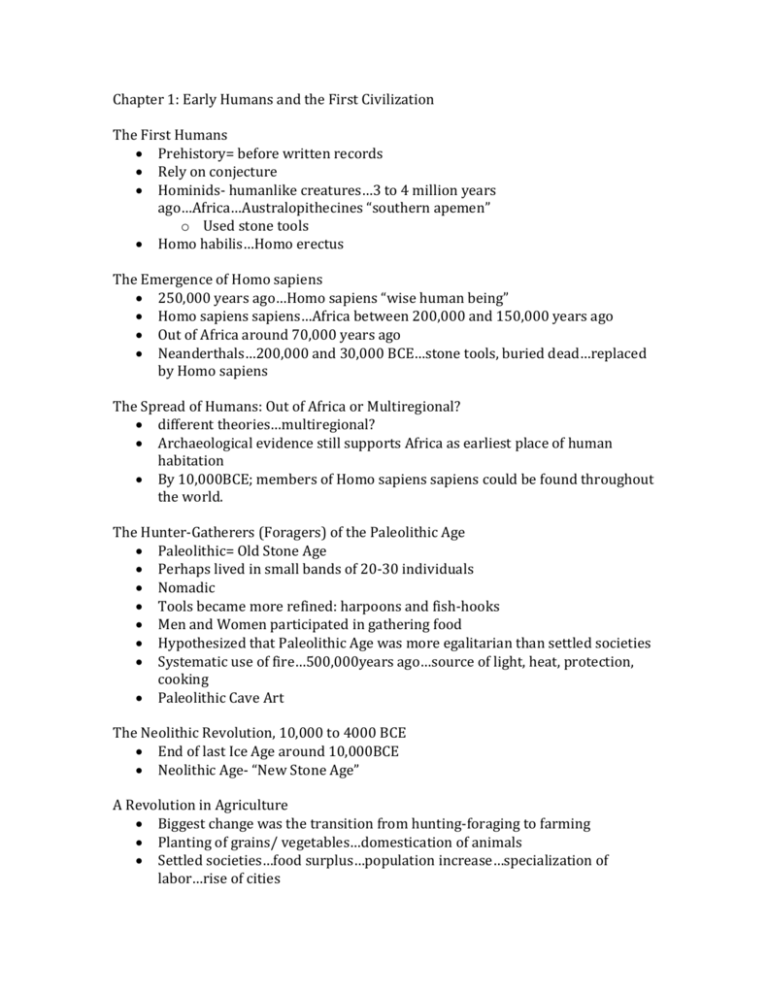
Chapter 1: Early Humans and the First Civilization The First Humans Prehistory= before written records Rely on conjecture Hominids- humanlike creatures…3 to 4 million years ago…Africa…Australopithecines “southern apemen” o Used stone tools Homo habilis…Homo erectus The Emergence of Homo sapiens 250,000 years ago…Homo sapiens “wise human being” Homo sapiens sapiens…Africa between 200,000 and 150,000 years ago Out of Africa around 70,000 years ago Neanderthals…200,000 and 30,000 BCE…stone tools, buried dead…replaced by Homo sapiens The Spread of Humans: Out of Africa or Multiregional? different theories…multiregional? Archaeological evidence still supports Africa as earliest place of human habitation By 10,000BCE; members of Homo sapiens sapiens could be found throughout the world. The Hunter-Gatherers (Foragers) of the Paleolithic Age Paleolithic= Old Stone Age Perhaps lived in small bands of 20-30 individuals Nomadic Tools became more refined: harpoons and fish-hooks Men and Women participated in gathering food Hypothesized that Paleolithic Age was more egalitarian than settled societies Systematic use of fire…500,000years ago…source of light, heat, protection, cooking Paleolithic Cave Art The Neolithic Revolution, 10,000 to 4000 BCE End of last Ice Age around 10,000BCE Neolithic Age- “New Stone Age” A Revolution in Agriculture Biggest change was the transition from hunting-foraging to farming Planting of grains/ vegetables…domestication of animals Settled societies…food surplus…population increase…specialization of labor…rise of cities More gradual: Mesolithic Age “Middle Stone Age” 10,000-7,000BCE Systematic agriculture developed independently in different areas of the world between 8000 to 5000 BCE Middle East/ Fertile Crescent- cultivation of wheat and barley China- rice/ millet/ pigs Mesoamerica: beans, squash, maize Neolithic Farming Villages growing of crops led to relatively permanent settlements Oldest in Middle East: Jericho: Canaan near Dead Sea by 8000BCE Catal Huyuk, modern Turkey, 32 acres, 6,000 inhabitants…few streets, holes in rooftops…gridlike pattern…food surplus led to specialization of labor…religious shrines Venus figurines/ “Earth Mothers”- religious? Fertility? Consequences of the Neolithic Revolution houses built for protection, and storehouses TRADE/ interdependence Specialization of Labor Obsidian- volcanic glass Hunting and Foraging Rise of Craftspeople Settled Improved Agriculture Tools Interdependence/ Rise of Cities Trade Food Surplus Social Stratification Specialization of Labor Economic Stratification Shift in gender roles…men assumed primary responsibility for working in the fields and herding animals…women cared for home and children Patriarchy: society dominated by men Enduring patterns: fixed dwellings, domesticated animals, regular farming, division of labor, men holding power…Neolithic Revolution as a turning point in human history Between 4000 to 3000BCE: development of writing for record keeping Metal-casting Copper was first metal used for producing tools, after 4000BCE- alloy of bronze (copper and tin) was created, and was more durable than copper Bronze Age: 3000BCE to 1200BCE….then Iron Age As wealth increased…cities needed protection…walled cities The Emergence of Civilization Focus Question: What are the characteristics of civilization, and what are some explanations for why early civilizations emerged? Civilization= complex culture in which large numbers of people share a variety of common elements 1. An urban focus…cities centers for political, economic, social, cultural, and religious development 2. New Political and Military Structures…organized government bureaucracy and armies 3. New social structure based on economic power…kings and upper class of priests, political leaders, and warriors dominated…free common people…very bottom of social hierarch= class of slaves 4. The development of more complexity in a material sense…agricultural surplus led to new occupations…demand for luxury items…organized trade grew substantially 5. A distinct religious structure…gods were deemed crucial to community’s success…professional priestly class 6. The development of writing…kings, priests, merchants, and artisans used writing to keep records (writing vs. record keeping) 7. New and significant artistic and intellectual activity…monumental architectural structures Early Civilizations Around the World Between 3000 and 1500BCE, the valleys of the Indus River in India supported a flourishing civilization…important cities= Harappa and Mohenjo-Daro Written records have yet to be deciphered Economy based on agriculture and trade with Mesopotamia Shang Dynasty, along Yellow River in Chinaa Also early civilizations: Central Asia (Turkmenistan and Uzbekistan)…Peru in Supe River Valley…Chavin Causes of Civilization Not really sure…material? Religious? Civilization in Mesopotamia Greek for “Between the Rivers” Needed large scale irrigation Tigris and Euphrates flooded unpredictably The City-States of Ancient Mesopotamia Sumerians…origins unclear…by 3000 BCE, had established independent citystates of Ur, Uruk, Umma, Eridu Sumerian Cities cities were surrounded by walls used sun-dried mud bricks Ziggurat= stepped tower/ temple Priestly class very important Theocracy: government by divine authority Kingship * Sumerians viewed kingship as divine in origin- agents of the gods Economy and Society primarily agricultural commerce and industry also important WHEEL around 3000BCE, led to carts Social classes: elites, dependent commoners, free commoners, slaves Empires in Ancient Mesopotamia A lot of conflict and warfare “smoke lies on our city like a shroud” Sargon’s Empire Akkadians to the north 2340 BCE: Sargon, leader of the Akkadians, overran the Sumerian city-states and established a dynastic empire o used former rulers as governors o Akkadian rule ended by 2100BCE 1792BCE: Hammurabi took control (Amorites/ Old Baylonians) Hammurabi’s Empire Hammurabi: 1792-1750BCE Well-disciplined army of footsoldiers Established a capital at Babylon Strong interest in state affairs The Code of Hammurabi: Society in Mesopotamia best known for law code of 282 laws “eye for an eye, tooth for a tooth” largest category of laws focused on marriage and the family punishments depended on status of those involved The Culture of Mesopotamia Spiritual worldview was of fundamental importance to Mesopotamian culture Importance of priestly class The Importance of Religion Physical environment had a big impact Ferocious floods, heavy downpours, scorching winds, oppressive humidity Polytheistic An, Enlil, Enki, Ninhursaga Divination through examining sacrificial animal’s entrails The Cultivation of Writing and Sciences Cuneiform- wedge shaped writing with reed stylus on clay tablets The Epic of Gilgamesh- epic king of Uruk…desire for immortality o Utnapishtim (similar to biblical Noah) Math: number system based on 60 Egyptian Civilization: “The Gift of the Nile” Nile River was crucial The Impact of Geography Longest river in the world Annual flooding Nile: transportation and farming Natural barriers: deserts, cataracts, Mediterranean Sea The Old and Middle Kingdoms Old, Middle, and New Kingdoms The Old Kingdom 3100BCE: first Egyptian royal dynasty under Menes, united Upper and Lower Egypt 2686-2180BCE Pyramids Pharaohs Ma’at: chief ruling principle of pharaohs…spiritual precept that conveyed the ideas of truth and justice and right order and harmony Vizier- “steward of the whole land”…in charge of bureaucracy Provinces- nomes…led by Nomarchs The Middle Kingdom 2055 to 1650BCE characterized by a new concern of the pharaohs for the people/ shepherds Society and Economy in Ancient Egypt organized along hierarchical lines…with god-king at top elites, merchants with international trade lower classes- serfs The Culture of Egypt achievements were part of a cosmic order suffused with the presence of the divine Spiritual Life in Egyptian Society Polytheistic Sun- Atun/ Re Osiris/ Isis/ Horus Cult of Osiris The Pyramids Pyramids Complex of buildings dedicated to the dead Spiritual body, called a ka Mummifcation Pyramids were tombs for the mummified bodies of the pharaohs Great Pyramid for King Khufu Art and Writing art was largely functional very formulaic hieroglyphics: “priest-carvings” Disorder and a New Order: The New Kingdom 1650BCE: Middle Kingdom ended with invasion of the Hyksos…used horsedrawn war chariots…brought bronze The Egyptian Empire 18th dynasty: made use of the new weapons to throw off Hyksos domination, reunite Egypt, establish the New Kingdom Queen Hatshepsut: Deir el Bahri…military expeditions…ceremonial beard Akhenaten and Religious Change Amenhotep changed his name to Akhenaten New capital at el-Amarna Failed attempt at monotheism Decline of the Egyptian Empire Ramesses II: 1279-1213BCE End of New Kingdom in 1070 Later Egypt was invaded by Alexander the Great, and became a part of the Roman Empire Daily Life in Ancient Egypt: Family and Marriage Generally married young…men could have multiple wives, if first wife was childless Women retained control of property and inheritance Marriage arranged by parents The Spread of Egyptian Influence: Nubia Nubia/ Sudan Then Nubia became Kush Kushite monarchs took control of Egypt until 663BCE New Centers of Civilization
